Home economics
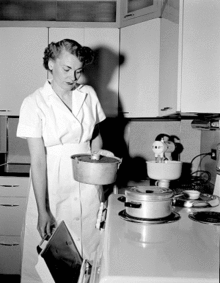
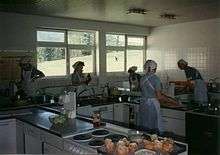
Home economics or domestic science, now known as family and consumer sciences (FCS), is the profession and field of study that deals with the economics and management of the home and community.[1] The field deals with the relationship between individuals, families, and communities, and the environment in which they live.
As a subject of study, FCS is taught in secondary schools, colleges and universities, vocational schools, and in adult education centers; students include women and men. It prepares students for homemaking or professional careers, or to assist in preparing to fulfill real-life responsibilities at home. As an academic profession, it includes educators in the field and human services professionals.[2]
The field represents many disciplines including consumer science, nutrition, food preparation, parenting, early childhood education, family economics, human development, interior design, textiles, apparel design, as well as other related subjects. Family and Consumer Sciences education focuses on individuals and families living in society throughout their lifespan, thus dealing not only with families but also with their interrelationships with the communities. Other topics such as sexual education, and fire prevention may also be covered.
Name
Family & Consumer Sciences was previously known in the US as Home Economics (often abbreviated "home ec" or HE"). In 1994, various organizations including the American Association of Family and Consumer Sciences adopted the new term "family and consumer science" to reflect the fact that the field covers aspects outside of home life and wellness.[2]
The field is also known by other names, including human sciences, home science, and domestic economy. In addition, home economics has a strong historical relationship to the field of human ecology, and since the 1960s a number of university-level home economics programs have been renamed "human ecology" programs, including Cornell University's program,[3] among others.
History

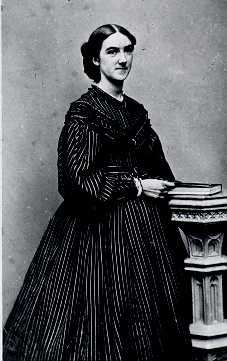
One of the first to champion the economics of running a home was Catherine Beecher, sister to Harriet Beecher Stowe. Catherine and Harriet both were leaders in mid-19th century North America in talking about domestic science. They came from a very religious family that valued education especially for women.
The Morrill Act of 1862 propelled domestic science further ahead as land grant colleges sought to educate farm wives in running their households as their husbands were being educated in agricultural methods and processes. Iowa, Kansas, Nebraska, Illinois, Minnesota and Michigan were early leaders offering programs for women. There were women graduates of these institutions several years before the Lake Placid Conferences which gave birth to the home economics movement.
The home economics movement started with Ellen Swallow Richards, who was the first woman to attend Massachusetts Institute of Technology and later became the first female instructor. Through her chemistry research, she became an expert in water quality and later began to focus on applying scientific principles to domestic situations. At the Chicago World’s Fair in 1893, she designed the Rumford Kitchen, which was a tiny kitchen that served nutritious meals to thousands of fair goers, along with a healthy dose of nutrition education. She shunned an invitation to participate in the Women’s Building as she said none of her research was just women’s work, but rather information for all.

Late in the 19th century, Richards convened a group of contemporaries to discuss the essence of domestic science and how the elements of this discipline would ultimately improve the quality of life for many individuals and families. They met at pristine Lake Placid, New York at the invitation of Melvil Dewey. Over the course of the next 10 years, these educators worked tirelessly to elevate the discipline, which was to become home economics, to a legitimate profession. Richards wanted to call this oekology or the science of right living. Euthenics, the science of controllable environment, was also a name of her choice, but "home economics" was ultimately chosen as the official term in 1899.[4] Richards then founded the American Home Economics Association (now called the American Association of Family and Consumer Sciences) in 1909.[4]
In the 1910s the AHEA won passage of two crucial pieces of legislation that allowed home economists to establish formal niches for research and teaching within institutions of higher education. The Smith-Lever Act of 1914 and the Smith-Hughes Act of 1917 provided funding to expand demonstration work in rural communities and to develop and teach a home economics curriculum on the campuses of most state land-grant colleges.[5]
Home economics emerged at the turn of the twentieth century as a movement to train women to be more efficient household managers. At the same moment, American families began to consume many more goods and services than they produced. To guide women in this transition, professional home economics had two major goals: to teach women to assume their new roles as modern consumers and to communicate homemakers’ needs to manufacturers and political leaders. The development of the profession with its origins as an educational movement to its identity as a source of consumer expertise in the interwar period to its virtual disappearance by the 1970s.[6]
In the 19th century, home economics classes were intended to ready young women for their duties in the home in healthy environments. Classes were first offered in the United States, Canada, Germany and Great Britain, followed by Latin America, Asia, and Africa. International organizations such as those associated with the United Nations have been involved in starting home economics programs around the world.[7]
Through the 1940s Iowa State College (later University) was the only program granting a master of science in household equipment. However, this program was centered on the ideals that women should acquire practical skills but also a scientifically based understanding of how technology in the household works. For example, women were required to disassemble and then reassemble kitchen machinery so they could understand basic operations as well as repair the equipment. In doing so, Iowa State effectively created culturally acceptable forms of physics and engineering for women in an era when these pursuits were not generally accessible to them.[8]
Home economists … found a receptive audience among many of its young female members who expressed interest in learning about how to improve their homes, spend their leisure time, and make decisions about what to buy, what to make at home, and even what books to read.[9]
A Standards Committee’s proposal in 1924 changed the AHEA constitution allowing for a special voting membership section clearing the way for HEIB (Home Economists in Business) section.[10] The largest group of HEIB members worked for food companies such as Washburn Crosby (later General Mills), Kellogg’s, ..or trade associations charged with promoting particular foods such as the Institute of American Meat Packers and the National Dairy Council. [Some] worked as journalists for women’s magazines such as.. the Ladies’ Home Journal. [Others] worked for utility companies.[11]
The function that home economists have been performing for more than a century remains key to our experiences as consumers, but the professional identity has disappeared. Indeed, efforts to reposition the discipline ultimately led to its renaming in the late twentieth century. In 1994, “home economics” was replaced by “family and consumer science.”…This renaming signaled a formal break from the field’s association with domesticity, highlighting instead issues of “family” and “consumption.” [12]
A new actor that rose to prominence in the 1980s was the charismatic celebrity unaligned with home economists or any other professional group. Martha Stewart and her fellow “domestic celebrities,” in television programs, books, magazines, and websites, attest to the continued importance of independent experts and commercial mass-media organizations in facilitating technological and cultural change in consumer products and services industries.[13]
To a great degree, Americans today tap into values once enshrined in a home economics curriculum to express a national identity and assert a standard of living that is distinct not only from Third World cultures but also from the cultures of other industrialized nations.... Even as luxury consumption exerts a cultural pull for many, middle-class culture still celebrates consumers who make sensible, controlled choices in the marketplace, resisting pure pleasure, impulse purchases, and cheap or shoddy goods.[14]
By country
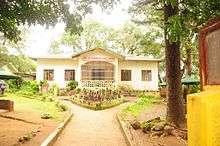
FCS is taught worldwide, both as an elective or as a required course in secondary education, and in many tertiary and continuing education institutions. Sometimes it is also taught in primary education. International cooperation in the field is coordinated by the International Federation for Home Economics, established in 1908.[15]
Germany
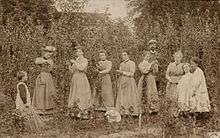
Between 1880 and 1900, the Reifenstein schools concept was initiated by Ida von Kortzfleisch, a Prussian noble woman and early German feminist. Reifenstein refers to Reifenstein im Eichsfeld, a municipality in Thuringia and site of the first permanent school. Reifensteiner Verband comprised from 1897 till 1990 about 15 own schools and cooperated with further operators. About 40 wirtschaftliche Frauenschulen, rural economist women schools were connected to the Reifensteiner concept and movement and allowed higher education for women already in the German Kaiserreich.[16] The 1913 doctorate of Johannes Kramer compared different concepts of home economic education world wide and praised the system e.g. in Iowa.[17]
South Korea
In South Korea, the field is most commonly known as "family studies" or "family science" (가정과학, gajeong-gwahak). The field began in schools taught by Western missionaries in the late 19th century. The first college-level department of family science was established at Ewha Womans University in Seoul in 1929.[18]
United States
In the United States, approximately 5 million students in US secondary education take FCS each year.[2]
Home science in India
Many Education boards in India such as NIOS,[19] CBSE, ICSE,[20] CISCE[21] and various state boards offer home science as a subject in their courses.
Content

Situated in the human sciences, home economics draws from a range of disciplines to achieve optimal and sustainable living for individuals, families, and communities. Historically, home economics has been in the context of the home and household, but this has extended in the 21st century to include the wider living environments as we better understand that the capacities, choices, and priorities of individuals and families impact at all levels, ranging from the household to the local and the global community. Home economists are concerned with promoting and protecting the well-being of individuals, families, and communities; they facilitate the development of attributes for lifelong learning for paid, unpaid, and voluntary work. Home economics professionals are advocates for individuals, families, and communities.
The content of home economics comes from the synthesis of multiple disciplines. This interdisciplinary knowledge is essential because the phenomena and challenges of everyday life are not typically one-dimensional. The content of home economics courses vary, but may include: food, nutrition, and health; personal finance; family resource management and planning; textiles and clothing; shelter and housing; consumerism and consumer science; household management; design and technology; food science and hospitality; human development and family studies; education and community services, among others. The capacity to draw from such disciplinary diversity is a strength of the profession, allowing for the development of specific interpretations of the field, as relevant to the context.
Cleaning
Home cleaning tasks can be separated into four categories: litter removal, storage of belongings, dusting, and washing of surfaces. Washing of surfaces is the most dangerous and complicated part because of the cleaning solutions. For example, hard water deposits are cleaned with acid solutions and grease is cleaned with alkaline solutions; they can both harm the skin and are reactive toward each other, potentially producing unwanted by-products. Mixing together chlorine bleach and strong acids (e.g. limescale remover containing HCl) forms chlorine gas, which is toxic. Solvents such as paint thinner and rubbing alcohol are toxic and flammable. Some disinfectants are toxic. Even dish water can require rubber gloves.[22]
Finances
Dealing with finances is a key element of home economics. Understanding concepts such as debt, credit, loaning, interest rates and so on are important to having a healthy economic home. Life skills such as making a budget, keeping financial records and making frugal purchasing choices are all part of this subject area. As home economics is a very holistic field, one must also incorporate concepts like purchasing power and how consumers can affect the global world.
Professional associations
The AAFCS (American Association of Family & Consumer Sciences) represents teachers, educators, cooperatives, business, designers and nutritionists.The American Association of Family & Consumer Sciences (AAFCS) is the only national forum where K-12 teachers, university educators, and corporate executives collaborate to improve the quality of individual and family life.
The Association for Career and Technical Education (ACTE) is the largest American national education association dedicated to the advancement of education that prepared youth and adults for successful careers. ACTE's core purpose is to provide leadership in developing an educated, prepared, and competitive workforce. The ACTE division of Family and Consumer Sciences Education includes three sections (1) NATFACS - National Association Teachers of Family and Consumer Sciences (2) NATEFACS - National Association Teacher Educators of Family andy Consumer Sciences, andy (3) NASAFACS - National Association State Administrators of Family and Consumer Sciences.
The National Council on Family Relations, (NCFR) founded in 1938, is the oldest multidisciplinary, nonpartisan professional organization focused solely on family research, practice and education. The premier professional association for the multidisciplinary understanding of families. The members’ interests—as diverse as their careers and backgrounds—are focused on topics and efforts that yield a common benefit: …understanding and strengthening families. NCFR members are professionals dedicated to understanding and strengthening families. Our 3,400-plus members come from more than 35 countries and all 50 U.S. states, and include: researchers, demographers, marriage and family therapists, parent/family educators, university faculty, students, social workers, public health workers, extension specialists and faculty, ECFE teachers, clergy, counselors, K-12 teachers, and more.
Areas of practice
Home Economics is also called Human sciences based on everyday work where the setting is the house. Home economics has four dimensions of practice:
- as an academic discipline to educate new scholars, to conduct research and to discover new knowledge and ways of thinking for professionals and for society
- everyday living in households, families and communities for developing life skills and develop potential for growth
- curriculum area that facilitates students to discover and further develop their own resources and capabilities
- influence and develop policy to advocate for individuals, families and communities to achieve empowerment and well-being, utilize transformative practices, and facilitate sustainable futures.
To be successful in these four dimensions of practice means that the profession is constantly evolving, and there will always be new ways of performing the profession.
See also
- Consumer economics
- Domestic technology
- Ellen Swallow Richards
- Euthenics
- Family (economics)
- Homemaker
- Human ecology
References
- ↑ International Federation for Home Economics (IFHE): Position Statement in: International Journal of Home Economics; Volume 1, Issue 1, available here
- 1 2 3 "FAQ". American Association of Family and Consumer Sciences. Retrieved 2015-01-11.
- ↑ "Why the Change to Human Ecology?". Cornell University. Retrieved 20 November 2012.
- 1 2 "AAFCS Brand Story" (PDF). American Association of Family & Consumer Sciences. Retrieved 20 November 2012.
- ↑ Goldstein, Carolyn M., 2012. Page 36. Creating Consumers: Home Economists in Twentieth-Century America. Chapel Hill: The University of North Carolina Press.
- ↑ Goldstein, Carolyn M., 2012. Dust jacket. Creating Consumers: Home Economists in Twentieth-Century America. Chapel Hill: The University of North Carolina Press.
- ↑ Phillips, Robert, Editor-in-Chief, et al. 1971. Funk & Wagnall’s New Encyclopedia. New York: Funk & Wagnall’s, Inc.
- ↑ Bix, Amy Sue (October 2002). "Gendered Technical Training and Consumerism in Home Economics, 1920-1980". Technology and Culture. 43 (4).
- ↑ Goldstein, Carolyn M., 2012. Page 13. Creating Consumers: Home Economists in Twentieth-Century America. Chapel Hill: The University of North Carolina Press.
- ↑ Goldstein, Carolyn M., 2012. Page 150. Creating Consumers: Home Economists in Twentieth-Century America. Chapel Hill: The University of North Carolina Press.
- ↑ Goldstein, Carolyn M., 2012. Page 149. Creating Consumers: Home Economists in Twentieth-Century America. Chapel Hill: The University of North Carolina Press.
- ↑ Goldstein, Carolyn M., 2012. Page 295. Creating Consumers: Home Economists in Twentieth-Century America. Chapel Hill: The University of North Carolina Press.
- ↑ Goldstein, Carolyn M., 2012. Page 299. Creating Consumers: Home Economists in Twentieth-Century America. Chapel Hill: The University of North Carolina Press.
- ↑ Goldstein, Carolyn M., 2012. Page 300. Creating Consumers: Home Economists in Twentieth-Century America. Chapel Hill: The University of North Carolina Press.
- ↑ "About IFHE". International Federation for Home Economics. Retrieved 2015-01-11.
- ↑ Ortrud Wörner-Heil: Adelige Frauen als Pionierinnen der Berufsbildung: die ländliche Hauswirtschaft und der Reifensteiner Verband kassel university press GmbH, 2010
- ↑ Johannes Kramer: Das ländlich-hauswirtschaftliche Bildungswesen in Deutschland, University of Erlangen doctorate, Fulda 1913
- ↑ 가정과학대학 70년사 (Gajeonggwahakdaehak 70-nyeonsa / 70 Years of the College of Family Science). Ewha Womans University Press. 1999. p. 7. ISBN 9788973003839.
- ↑ http://www.nios.ac.in/currisylhs-eng.pdf
- ↑ http://cbse.nic.in/examin~1/scheme06ex.htm
- ↑ http://www.cisce.org/data/.../27.%20Home%20Science.pdf
- ↑ Bredenberg, Jeff, ed. 1998. Clean it Fast, Clean it Right. Emmaus, PA: Rodale.
Further reading
- Goldstein, Carolyn M. (2012). Creating Consumers: Home Economists in Twentieth-Century America. Chapel Hill, NC: University of North Carolina Press.
- Lee, Tsz Ngong (1999). "Home Economics". In Altenbaugh, Richard J. Historical Dictionary of American Education. Greenwood Press. pp. 175–176. ISBN 031328590X.
- Solomon, Barbara Miller (1985). In the Company of Educated Women. Yale University Press. ISBN 0300033141.
- Tolley, Kim (2003). The Science Education of American Girls. RoutledgeFalmer. ISBN 0415934737.
- Walker, Melissa (1998). "Home Economics". In Eisenmann, Linda. Historical Dictionary of Women's Education in the United States. pp. 201–206. ISBN 0313293236.
- Woody, Thomas (1929). A History of Women's Education in the United States. 2 (1966 reprint ed.). Octagon Press.
- Nutrition Education - Making it work By Dr. Janet Reynolds
- People and Practice: International Issues for Home Economists by Elanour Vaines, Doris Badir and Dianne Kieren
- Toward an Ideal of the Person Educated in Home Economics: An Invitation to Dialogue by Jane Thomas and Gale Smith
- Sustainable food futures: Lessons for home economics pedagogy and practice by Martin Caraher and Janet Reynolds
- Shapiro, Laura (2008). Perfection Salad. University of California Press.
External links
- Societies and associations
- International Federation for Home Economics (IFHE)
- American Association of Family and Consumer Sciences
- National Extension Association of Family and Consumer Sciences
- Teachers of Home Economics Specialist Association
- Resources
- "What Was Home Economics?" web pages at the Cornell University library on the history and influence of home economics
- USDA Cooperative State Research, Education, and Extension Service
- Home Economics Archive: Tradition, Research, History (HEARTH)
- Family Consumer Science Lesson Plans
- National Standards for Family and Consumer Sciences Education (India)
- Family, Career and Community Leaders of America (FCCLA)
- Family Consumer Science Lessons